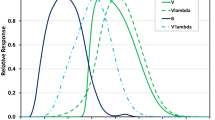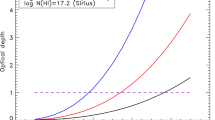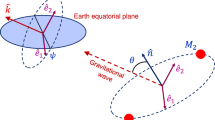Abstract
The intensity variation of 557.7 nm oxygen green line and 630.0 nm oxygen red line at Kiso observatory, Tokyo, and variations in critical frequency of the ionospheric F2 layer (foF2) and semi transparency coefficient related to the E layer before earthquakes with magnitude ≥ 5 are considered for 1979 to 1990. The intensity of both the lines increases within six days before earthquakes; foF2 and semi transparency coefficient abnormally increase before enhancement of airglow. The superposed epoch analysis of each variable is done for further confirmation. Some physical processes in atmosphere-ionosphere in pre-seismic days enhance the concentration of electron and neutral molecules in the ionospheric F and E regions. These events influence the dissociative recombination processes related to oxygen emission, and so the intensity of two line emissions show some special type of variations during earthquake events.
Similar content being viewed by others
References
M. Bath, Physics and Chemistry of the Earth (Pergamon Press, New York, 1966).
S.K. Midya and P.K. Gole, “Trend of major earthquakes during the period 1900–2011 and its association with some solar and geomagnetic parameters,” Indian J. Phys. 88 (1), 1–4 (2014).
S. Dey and R. Singh, “Surface latent heat flux as an earthquake precursor,” Nat. Hazards Earth Syst. Sci. 3, 749–755 (2003).
G. Cervone, S. Maekawa, R.P. Singh, M. Hayakawa, M. Kafatos, and A. Shvets, “Surface latent heat flux and nighttime LF anomalies prior to the Mw = 8.3 Tokachi-Oki earthquake,” Nat. Hazards Earth Syst. Sci. 6, 109–114 (2006).
M. Kafatos, D. Ouzounov, S. Pulinets, G. Cervone, and R. Singh, “Energies associated with the Sumatra earthquakes of December 26, 2004 and March 28, 2005,” in AGU Fall Meeting (San Francisco, 2007).
S.K. Midya, A.K. Dutta, and P. Panda, “Association of major earthquakes (magnitude ≥ 6 Richter scale) with geomagnetic activity index Kp during the period 2001–2007,” Mausam 62 (2), 245–252 (2011).
G.Q. Zhang, “Relationship between global seismicity and solar activities,” Acta Seismologica Sinica 11 (4), 495–500 (1998).
S.K. Midya, A. Das, and N. Karmakar, “Association of occurrence of major earthquakes throughout the globe with variable component of the green line Fe XIV 530.3 nm during 1950–2014,” Indian J. Phys. 90 (12), 1–5 (2016). doi 10.1007/s12648–016–0875–0
S. Mukherjee, “Cosmic influences on the sun-earth environment,” Sensors 8 (12), 7736–7752 (2008).
N.D. Ganguly, “Variation of atmospheric ozone concentration following strong earthquake,” Int. J. Remote Sens. 30 (2), 349–356 (2009).
S.K. Chakrabarty, M. Saha, R. Khan, S. Mandal, K. Acharyya, and R. Saha, “Possible detection of ionospheric disturbances during the Sumatra-Andaman islands earthquakes of December 2004,” Indian J. Radio Space Phys. 34 (5), 314–318 (2005).
S.S. De, B. Bandyopadhyay, T.K. Das, S. Paul, D.K. Haldar, B.K. De, S. Barui, M. Sanfui, P. Pal, and G. Chattopadhyay, “Studies on the anomalies in the behaviour of transmitted subionospheric VLF electromagnetic signals and the changes in the fourth schumann resonance mode as signature of two pending earthquakes,” Indian J.Phys. 85 (3), 447–470 (2011).
S. Ray, S.K. Chakrabarty, and S. Sasmal, “Precursory effects in night time VLF signal amplitude for the 18th January 2011 Pakistan earthquake,” Indian J. Phys. 86, 85–88 (2012).
S. Sasmal, S.K. Chakrabarty, and S. Ray, “Unusual behaviour of very low frequency signal during the earthquake at Honsu/Japan on 11 March, 2011,” Indian J. Phys. 88, 1013–1019 (2014).
O.A. Molanchov, M. Hayakawa, T. Ondoh, and E. Kawai, “Precursory effects in the subionospheric VLF signals for the Kobe earthquake,” Phys. Earth Planet. Inter. 105, 239–248 (1998).
E.V. Liperovsky, A.S. Silina, A. Saidshoev, V.A. Liperovsky, C.V. Meister, and N.E. Sasileva, “On the effect of spread-Es of night sporadic layers,” Geomagn. Aeron. 40 (1), 112–114 (2000).
S.A. Pulinets, K.A. Boyarchuk, V.V. Hegai, V.P. Kim, and A.M. Lomonosov, “Quasi electrostatic model of atmosphere-thermosphere-ionosphere coupling,” Adv. Space Res. 26, 1209–1218 (2000).
S.K. Jain, G. Panda, and S.K. Vijay, “Study of variation of slab thickness of ionospheric F region during earthquake by wavelet analysis,” Indian J. Phys. 84, 359–365 (2010).
J.Y. Liu, Y.I. Chen, S.A. Pulinets, Y.B. Tsai, and Y.J. Chuo, “Seismo-ionospheric signatures prior to M ≥ 6.0 Taiwan earthquakes,” Geophys. Res. Lett. 27, 3113–3116 (2000).
S. Ghosh, S. Sasmal, S.K. Midya, and S.K. Chakrabarti, “Unusual change in critical frequency of F2 layer during and prior to earthquakes,” Open J. Earthquake Res. 6, 191–203 (2017).
J.Y. Liu, Y.J. Chuo, S.J. Shan, Y.B. Tsai, Y.I. Chen, S.A. Pulinets, and S.B. Yu, “Pre-earthquake ionospheric anomalies registered by continuous GPS TEC measurements,” Ann. Geophys. 22, 1585–1593 (2004).
M. Devi, A.K. Barbara, and A. Depueva, “Association of Total Electron Content (TEC) and foF2 variations with earthquake events at the anomaly crest region,” Ann. Geophys. 47, 83–91 (2004).
A. Trigunait, M. Parrot, S. Pulinets, and F. Li, “Variation of the ionospheric electron density during the Bhuj seismic events,” Ann. Geophys. 22, 4123–4131 (2004).
M. Akhoondzadeh, M. Parrot, and M.R. Saradjian, “Electron and ion density variations before strong earthquakes (M > 6.0) using DEMETER and GPS data,” Nat. Hazards Earth Syst. Sci. 10, 7–18 (2010).
S. Sarkar, S. Choudhury, S. Sonakia, A. Vishwakarma, and A.K. Gwal, “Ionospheric anomalies associated with the Haiti earthquake of 12 January 2010 observed by DEMETER satellite,” Nat. Hazards Earth Syst. Sci. 12, 671–678 (2012).
S.A. Pulinets and M.A. Dunajecka, “Specific variation of air temperature and relative humidity around the time of Michoacan earthquake M8.1 Sept. 19, 1985 as a possible indicator of interaction between tectonic plates,” Tectonophysics 431, 221–230 (2007).
S.A. Pulinets, “Lithosphere-atmosphere-ionosphere coupling (LAIC) model,” in Electromagnetic Phenomena Associated with Earthquakes (Transworld Reaserch Network, 2009), pp. 235–254.
L.M. Fishkova, M.B. Gokhberg, and V.A. Pilipenko, “Relationship between night airglow and seismic activity,” Ann. Geophys. 3, 689–694 (1985).
L.M. Fishkova, “Seismic activity effect in variations of the nighttime emission of the upper atmosphere of the Earth,” Soobshcheniia Gruzinskoi Akademii Nauk 116, 89–92 (1984).
T.I. Toroshelidze and L.M. Fishkova, “Manifestation of seismic activity in nightglow variations,” Poliarnye Stiantsii: Svechenic Nochnogo Neba 33, 17–23 (1989).
G.G. Didebulidze, L.M. Fishkova, A.D. Pataraya, and T.I. Toroshelidze, “Investigation of night sky airglow near the epicenter of the earthquake,” Plasma Astrophys. 8, 321–327 (1990).
G.A. Nasyrov, “Correlation between night sky emission and seismic activity,” Izv. Acad. Nauk Tadzh. SSR 2, 119–122 (1978).
A.V. Mikhalev, M.S. Papov, and E.S. Kazimirovsky, “The manifestation of seismic activity in 557.7 nm emission variations of the Earth’s upper atmosphere,” Adv. Space Res. 27, 1105–1108 (2001).
A.V. Mikhalev, “[OI] 557.7 nm airglow during seismic events in the Baikal rift zone,” Atmos. Ocean. Opt. 30 (3), 243–247 (2017).
M.P. Korobeinikova, R.N. Kulieva, M. Goshdzhanov, V.G. Khamidulina, and A.A. Shamov, “Variation of 557.7 nm, 630.0 nm and Na nightglow emissions during earthquake periods,” Poliarnye Stiantsii: Svechenic Nochnogo Neba 33, 24–27 (1989).
D. Barbier, “The light of the night sky in summer in Taamanrasset,” Comptes Rendus Acad. Sci. 245, 1559–1561 (1957).
D. Barbier, “Research on the 6300 line of night airglow,” Ann. Geophys. 15, 179–217 (1959).
A.S. Silina, E.V. Liperovskaya, V.A. Liperovsky, and C.V. Meister, “Ionospheric phenomena before strong earthquakes,” Nat. Hazards Earth Syst. Sci. 1, 113–118 (2001).
Author information
Authors and Affiliations
Corresponding author
Additional information
The article is published in the original.
Rights and permissions
About this article
Cite this article
Gole, P.K., Midya, S.K., Panda, P. et al. Intensity Variations of OI 557.7 nm and OI 630.0 nm Lines before M5.0 and Greater Earthquakes in Tokyo Region, Japan, in 1979 to 1990. Atmos Ocean Opt 31, 670–677 (2018). https://doi.org/10.1134/S1024856018060210
Received:
Published:
Issue Date:
DOI: https://doi.org/10.1134/S1024856018060210




